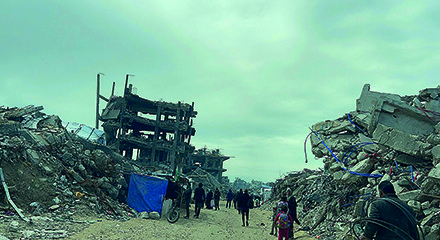23.10.2025

Survival is a kind of victory
As Hamas moves to reassert control in Gaza, where does the Trump ‘peace deal’ leave it? There can be no question that it has been severely weakened militarily, but now it has gained a reprieve, argues Yassamine Mather
For many Gazans, exhausted by two years of devastating conflict that has claimed at least 70,000 lives, there are good reasons to celebrate the ceasefire - however short it might be - and the release of 2,000 Palestinian prisoners held by Israel. However, this does not mean we are witnessing a Hamas victory. Far from it.
After nearly two decades of unchallenged rule in Gaza, Hamas finds itself in a difficult position. Following the ceasefire with Israel on October 10, the group has shown little sign of surrendering what power it has left, let alone disarming. It is attempting to reassert control - Hamas fighters, at times masked, have been seen beating and executing those who cooperated with the IDF, looters and members of armed criminal gangs. But all this hides a bitter reality. Having lost a good portion of its military and political leadership, as well as fighters, and under pressure from regional allies and paymasters, Hamas had little choice but to accept the Trump ‘peace deal’.
Within Gaza attitudes to Hamas vary. Aid worker Hanya Aljamal, writing on social media, argues that despite its brutality, Hamas is still preferable to criminal gangs. Meanwhile, Dr Ahmad Yousef, a former Hamas advisor, who has at times been critical of the group, told the BBC that a firm hand is necessary until international forces arrive to stabilise Gaza. On the other hand, both supporters and opponents of Hamas agree that, under the current ‘peace deal’, even if the group does not give up all its weapons, its hold on power will be considerably reduced.
Despite surviving militarily and politically, we can say that the current peace proposal represents a strategic setback for Hamas. The demand that it disarms and accepts a monitored, demilitarised Gaza cuts directly into the core of the organisation’s self-definition. Since its founding in 1987, Hamas has portrayed itself primarily as an armed resistance movement - one that claims legitimacy through its military struggle against Israel. Its political authority, internal cohesion and grassroots support are deeply tied to this image of resistance. To relinquish its weapons would not only end its military capacity, but undermine the ideological foundations on which its identity and influence rest.
Moreover, a ‘demilitarised’ Gaza overseen by international monitors would drastically reduce Hamas’s ability to control Gaza’s aid distribution network, legal system, border crossings and patronage networks. ‘Demilitarisation’ would transfer much of that control to external actors - possibly the UN, Arab states or a multinational body.
The creation of a transitional administration, envisioned as a technocratic and internationally supervised authority, creates many challenges for Hamas. Under this framework, Hamas’s role would be marginalised to being a mere local political faction operating within rules set by external powers. Even if it were allowed some participation, its activities would be subject to international supervision: it will have little freedom to act independently or pursue policies that conflict with the broader objectives of the Trump ‘peace deal’.
In other words, the entire thing represents a fundamental threat to Hamas’s identity and survival as both a militant organisation and a governing force. Then there are the war captives. The group clearly faced extraordinary difficulties keeping those who still lived alive and fed. Hamas reportedly came to the view that “its continued holding of hostages had become a liability for it rather than leverage”.1 In other words, the international diplomatic cost, the pressure on Hamas and the reputational impact were mounting, making the release of Israeli hostages more necessary.
Hamas rightly points out that the delay in returning the bodies of dead Israelis is because those guarding the bodies were killed during the last months of heavy bombing. As for the living Israelis released over the lasts few weeks, they seemed to be in relatively good health, given two years in captivity. By contrast, the Palestinians freed from Israeli jails and holding pens looked undernourished, many clearly suffering from the aftereffects of physical and mental torture (most of the 2,000 who were released were called ‘prisoners’ by Israel, but some, including many teenagers, were detained with no charge, while others were reaching the end of their sentences).
According to a report in The Guardian, an official from Gaza health ministry told the paper: “At least 135 mutilated bodies of Palestinians returned by Israel to Gaza had been held in a notorious detention centre already facing allegations of torture and unlawful deaths in custody.”2
Leave aside the goal of a greater Israel and annexation. The publicly declared war aims of Benjamin Netanyahu’s coalition government have been threefold:
- Returning the war captives to Israel.
- Neutralising Hamas politically and militarily - dismantling its command structure, tunnel networks, weapons stockpiles and leadership hierarchy.
- Ensure Hamas no longer poses a threat to Israel.
Even though these objectives are now partially translated into Trump’s ‘peace’ framework, the colonial logic remains the same. The plan entrenches Palestinian oppression and increases Israel’s strategic leverage. Moreover, Hamas is now cornered militarily and politically, while Israel enjoys robust US, European and regional Arab support (particularly from Egypt, Jordan and Gulf states seeking stability). This alignment ensures Israel’s long-term upper hand in any post-war settlement.
Even if, as should be expected, Hamas survives, it does so under sustained pressure on multiple fronts:
- Militarily, its infrastructure is degraded, its leadership decimated and its logistics severely disrupted.
- Diplomatically and financially, it is ever more reliant on intermediaries, not least Qatar.
- Domestically, it is quite possible that its standing in Gaza is much diminished - not least because of the huge human cost of the war. On the West Bank, on the other hand, it is quite possible that its popularity has grown.
Hamas’s refusal to fully disarm might appear like an act of defiance, but in reality it underscores weakness. It cannot fight indefinitely, yet it also cannot accept total surrender without forfeiting its ideological legitimacy. This dynamic produces a form of ‘defeat by negotiation’ - a process where Hamas loses autonomy and legitimacy without being decisively crushed on the battlefield.
In effect, Hamas remains alive, but is severely constrained - its military power degraded and its political ambitions increasingly quixotic.
The ceasefire provides Hamas with a temporary pause, but no victory. The organisation can use this respite to rebuild its networks, restore a degree of civil governance functions and reassert its social influence.
Symbolically, Hamas can claim it survived a campaign aimed at its annihilation. Survival itself becomes a narrative of endurance, allowing it to project resilience to its followers and the broader Arab world. Yet survival without sovereignty or strategic initiative is hollow - a reprieve, nothing more.
October 21 saw Israel’s 120-seat Knesset vote 25:24 to give preliminary approval to a far-right sponsored bill to extend sovereignty over the entire West Bank. That despite opposition from Netanyahu and his Likud Party - he wants to do nothing to upset the Americans. Most Likud KMs abstained or stayed away.
However, the general view is that the vote is performative. A push-back against American arm twisting Israel into accepting its Gaza deal.
Either way, the bill will now go to the Foreign Affairs and Defence Committee. There would, of course, need to be three more Knesset votes before it passes into law.
That is doubtful. What is clear, though, is Israel’s wish to colonise the whole of the Promised Land ... and that means getting rid of the People of the Land.
